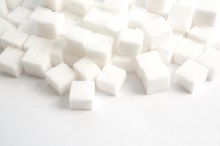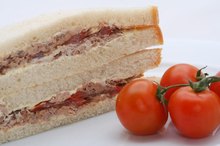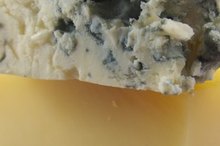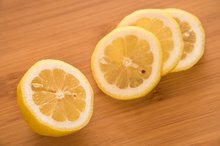Macromolecules in the Human Digestive System
When you eat food, you take in large molecules called macromolecules that are made up of building blocks that you can absorb into the bloodstream, and that your cells can burn for energy. Your digestive tract breaks down these macromolecules to liberate their building blocks so that the small intestine can absorb them.
Starch and Sugars
Starch, known chemically as amylose, and sugars fall into the category of carbohydrates. They're made entirely of carbon, hydrogen and oxygen. Both starch and sugars are made up of smaller building block molecules called monosaccharides, where the word means "single sugar unit." Starch consists of many monosaccharides chemically bonded together, while sugars are only one or two. You use enzymes called amylases to break apart the monosaccharides in amylose, while you use a variety of sugar-digesting enzymes to break apart the monosaccharides in two-unit sugars. You then absorb the monosaccharides into the bloodstream.
Protein
Sucrose, Dextrose & Maltodextrin
Learn More
Protein is the most varied of the macromolecules in terms of its variety of shapes and forms. All proteins, however, are made up of building blocks called amino acids, which are bonded together in long chains by connections called peptide bonds. You use enzymes called proteases to break down proteins, according to Drs. Reginald Garrett and Charles Grisham in their book "Biochemistry." Protein digestion starts later along the digestive tract than starch digestion and takes longer.
Fat
Unlike starch and protein, fat isn't made up of a long chain of repeating smaller units. Instead, fat molecules -- called triglycerides -- consist of three fatty acid units chemically bonded to a single backbone molecule called a glycerol, which is similar in chemical structure to alcohol. When you digest fat, you break two of the fatty acids away from the glycerol backbone, say Drs. Mary Campbell and Shawn Farrell in their book "Biochemistry." You absorb these, as well as the remaining fatty acid, which is still bonded to glycerol.
Fiber
What Do Carbohydrates, Lipids & Proteins Have in Common?
Learn More
The final macromolecule that passes through your digestive tract is a carbohydrate, like starch and sugars, but it isn't one you can digest. Cellulose -- also called fiber -- is made up of long chains of monosaccharides like starch. The bonds are shaped differently, however, which means your digestive enzymes can't break fiber down. As a result, it passes through your digestive tract undigested and you don't extract any chemical energy from it or absorb its components.
Related Articles
References
- “Biochemistry”; Reginald Garrett, Ph.D. and Charles Grisham, Ph.D.; 2007
- “Biochemistry”; Mary Campbell, Ph.D. and Shawn Farrell, Ph.D.; 2005
Writer Bio
Kirstin Hendrickson is a writer, teacher, coach, athlete and author of the textbook "Chemistry In The World." She's been teaching and writing about health, wellness and nutrition for more than 10 years. She has a Bachelor of Science in zoology, a Bachelor of Science in psychology, a Master of Science in chemistry and a doctoral degree in bioorganic chemistry.









